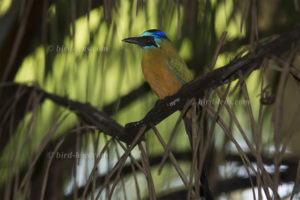 The Blue-crowned Motmot (Momotus momota) is so common in the Pantanal, that you hardly can miss it. Besides being one of the most colorful birds of the Pantanal, it is also one of the most spectacular birds of the Pantanal by the colorful and unique shape of the tail feathers. The bird is specialized in hunting insects and small vertebrates from a fixed landing.
The Blue-crowned Motmot (Momotus momota) is so common in the Pantanal, that you hardly can miss it. Besides being one of the most colorful birds of the Pantanal, it is also one of the most spectacular birds of the Pantanal by the colorful and unique shape of the tail feathers. The bird is specialized in hunting insects and small vertebrates from a fixed landing.
The song is similar to that of an owl, most often emitted in the lightening and darkening, although it can be heard at any time of day and night. It starts with a short, severe, accelerated call (understood as udu or hard). When another Blue-crowned Motmot responds, they accelerate the singing and increase the number of “udus”.
Although it activates its calls all day, it is impressive how difficult it is seeing it in the shadows of the vegetation, despite the intense color of the body and head, besides the size of the tail. The bright green of the plumage is yellowish on the belly and chest. Around the red eyes, a large black mask is ending in two ends. Ripping the entire mask, the intense cobalt blue is lighter and more extensive on the forehead. The Top of the head is black. Wings and tail show a bluish tip. Male and female are identical, with the same appearance. On the chest, two black feathers look like a bow tie.
The tail is long, with the central feathers longer than the body and with the smaller and staggered ones. At the tip of the central feathers two rackets appear. Where the lateral fringes of the feather were lost only the tip remains. This structure draws even more attention when the Blue-crowned Motmot moves the tail sideways, especially when it is observed. It originates from the natural loss of the lateral structures of the pen after its formation. The Indians interpreted this form as being the result of the transport by the Blue-crowned Motmot of the coals sent by the gods to light the first fire of the human beings.
The nest of the Blue-crowned Motmot in Pantanal is a hole in a ravine of river or oxbow. The hole has a diameter of more than a meter sometimes. In the jungles and ridges without gully, the bird take advantage of the entrance of the hole of an armadillo to begin the excavation of its horizontal tunnel just below the level of the ground. Having the bird about 45 inches, with its tail, there remains the question of how it comes in and out without damaging its long special feathers.
The location of the photo-shot was taken on the farm Pouso Alegre. This is a pousada which is very well situated 7 km away from the Transpantaneira. The location is only 33 km south of Pocone in the northern Pantanal. The hole pousada is a great nature-area with original landscape and extensive cattle ranching. A paradise for the keen birdwatcher as well as for the beginner in birdwatching.
The owner is present much of the time, and is a dedicated naturalist. If you are birders you will be pleased with the birding opportunities, including Hyacinth Macaws in front of the porch. On the way you will see of Jabiru storks, herons and raptors a lot. You can go on other guided hikes or horseback rides. It’s all custom and small-scale. The scenery is beautiful.
Bird-lens is mainly a website to suit the growing demand for top shots of the species of the Western Palearctic. But of interest is the phenomenon of bird migration in general. Trips to tourist and non-tourist spots like Thailand or the Seychelles to capture images of rare migrating birds are part of the program and were already very successful. More nice images you find in the gallery of Pouse Alegre birds or in the “Pictures Shop”. Just give me a message, if Bird-lens could serve you with images also outside the range of the Western Palearctic. Images of e.g. South America are well on stock, too. The nice images you find in in the gallery are only a first impression, what you might find in the gallery in the “Picture Shop” too. Just give bird-lens.com a message, if bird-lens.com could serve you with an image needed before other pictures are online.